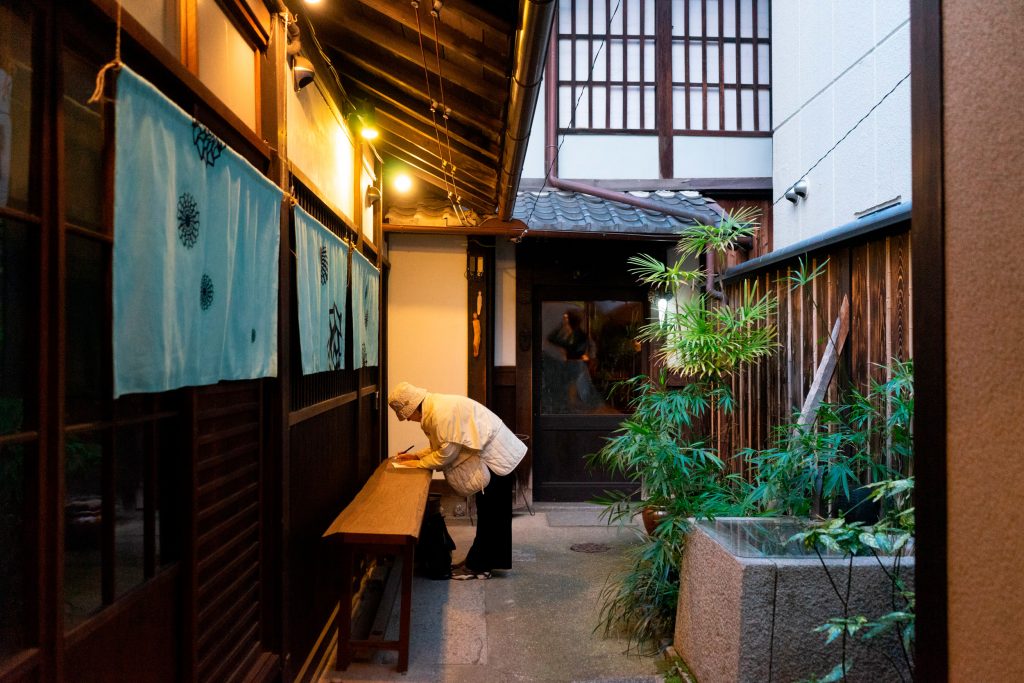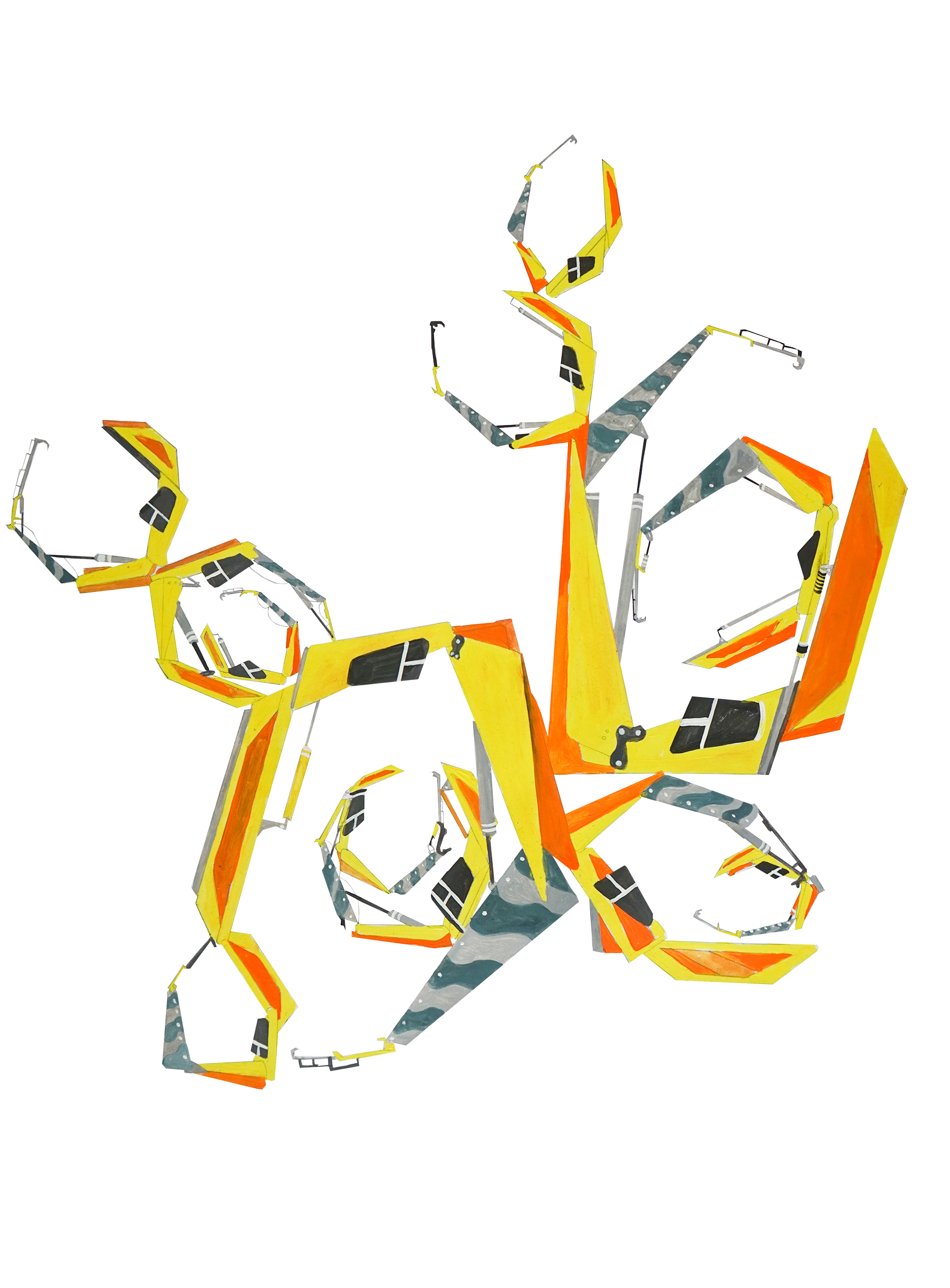


Dissipating Grid 二 &一 180 x 150 cm, Katazome, Stencil Dyeing on Silk, 2023-2024
染め DYEING

In 染め DYEING the artist documents herself during the creation of Dissipating Grid. She decides to set up a camera and chooses self-surveillance to follow every step of a demanding work process. The film features interactions with teachers and peers, testifying the challenges of assimilating into a different cultural surrounding. Yet the artist mostly works in solitude within a secluded space — the textile studio. 型染め Katazome develops around its key elements such as silk, water, rice and wood, reflecting the changing seasons of Japan.
染め DYEINGでは、アーティストがDissipating Gridの制作過程を自ら記録しま す。彼女はカメラをセットし、自己監視を通じて厳しい制作過程のすべてのステップを 追いかけることを決定します。この映像は、教師や仲間との交流を記録しており、異 文化の中で適応していく挑戦を証言しています。それでも、アーティストは主に孤独 の中で、隠れた空間—テキスタイルスタジオ—で作業しています。型染(Katazome) は、絹、水、米、木といった重要な要素を中心に展開し、日本の四季の移り変わりを 反映しています。

障子 Shōji
障子 Shōji are traditional Japanese-style paper windows with a wooden grid structure. When light passes through Shōji, rays of sunshine enter a house with a distinctive grided shadow. The grid pattern that can be found in the stencil-dyed Kimono worn by the dancer. Windows of undyed White dance on the floating deep blue silk as the body moves in solitude. Light transcends the fabric into the body through the grid – on a literal and spiritual level. The grid frequently appears in the rich history of Abstract Painting which is the medium in which the artist mostly works in. This generates a dialogue between Painting and Textiles, two artistic mediums traditionally viewed as separate.

舞踏 Butoh is an Avant-Garde dance form, also known as 暗黒舞踏 ‚dance of darkness‘, was founded by 大野 一雄 Kazuo Ōno and 土方巽 Tatsumi Hijikata in Japan‘s post-war era. The practice of Butoh is deeply rooted in improvisation as the art form „resists fixity“. The performance piece was created in collaboration with 今貂子 Tenko Ima, who is a pioneer of the anti-establishment dance movement.

障子(Shōji)、パフォーマンス作品、2024年、京都、日本障子は、日本の伝統的な紙の窓で、可動式 の扉としても使用される木製の格子構造を持っています。光が障子を通り抜けると、マチヤの家に 特徴的な格子模様の影が差し込みます。この格子模様は、踊り手が着用する型染めされた着物に も見られます。未染の白い部分が浮かぶ深い藍色の絹の上で、体が孤独に踊ります。光は格子を通 して布から体へと伝わり、文字通りそして精神的に体を照らします。格子模様は、アーティストが主に 取り組んでいる抽象絵画の豊かな歴史にも頻繁に現れます。このことは、絵画とテキスタイル、二つ の伝統的に別個と見なされてきた芸術分野の対話を生み出します。後者は「女性の労働」としての 意味合いを持っています。

舞踏(Butoh)は、前衛的な舞踏形式で、暗黒舞踏(Dance of Darkness)とも呼ばれ、大野一雄 (Kazuo Ōno)と土方巽(Tatsumi Hijikata)によって戦後日本で創始されました。舞踏の実践は即興に深く根ざしており、この芸術形式は「固定化に対する抵抗」とされています。このパフォーマ ンス作品は、反体制的な舞踏運動の先駆者である今貂子(Tenko Ima)とのコラボレーションで制 作されました。
障子 Shōji, 舞踏 Performance, In collaboration with 今貂子 Tenko Ima, 2024, Kyoto, Japan
Dissipating Grid – Solo Exhibition
Sakaimachi Garow Gallery, Kyoto, Japan, 2024

個展 About the exhibition
The gallery is delighted to present Dissipating Grid, a solo exhibition by Mison Schreff. The show takes place at Sakaimachi Garow Gallery in Kyoto in February of 2024. Hand sewn Kimonos and other immersive, large-scale Katazome works are displayed in the traditional Kyoto-style Machiya townhouse dating back to 1905. This includes three spaces-the foyer, garden and main hall with seven metres of height. Only natural mate- rials such as hemp and bamboo are used to complement the existing architectural structures made of wood and clay.


展覧会について I ギャラリーは、ミソン・シュレフの個展「Dissipating Grid」を発表することを嬉しく思い ます。この展覧会は、2024年2月に京都の坂井町ガロウギャラリーで開催されます。手 縫いの着物や他の大規模な型染め作品が、1905年に建てられた伝統的な京都スタ イルの町家で展示されます。展示空間は、玄関、庭、そして高さ7メートルのメインホー ルの3つのエリアから成り立っています。hemp(麻)や竹などの自然素材が、木と粘土 で作られた既存の建築構造を補完しています。


型染め Katazome Work Process

型染め Katazome is a unique Japanese stencil dyeing technique using rice resist paste. It‘s first introduction in Japan dates back to the 8th century. The work process is labour-intensive and involves cutting stencil paper, applying rice resist-paste, steaming, washing and sewing by hand. Colour, made up of various pigments, is applied meticulously through paintbrushes. The area of the silk protected by 海 苔 のり Nori paste resists the application of dye, hereby leaving undyed segments in the silk. Katazome is distingiushed by bold and sharp lines, often in Indigo colour, Japan‘s colour of dyeing. The artist chose to use a range of blue tones to evoke strong cultural associations. By incorporting only natural elements such as water, rice and wood Katazome is a completely sustainable method of dyeing.


型染(Katazome)は、米糊を使った日本の伝統的な型染め技法です。この技法の日本への導入は8世紀に遡ります。制作は、型彫り、糊置き、型紙外し、染色、蒸しなど 18の工程からなります。様々な顔料を使い、筆を使って丁寧に塗られます。糊置き (Nori paste)で保護された絹の部分は染料が染み込みません。アーティストは、強 い文化的な関連性を呼び起こすために、さまざまな青色を使用することを選びまし た。水、米、木など、自然の要素のみを取り入れることで、型染めは完全に持続可能な染色方法となっています。


DISSIPATING GRID was created during the working period from June 2023 to February 2024 at 京都精華大学 Kyoto Seika University Textile department, Japan.
